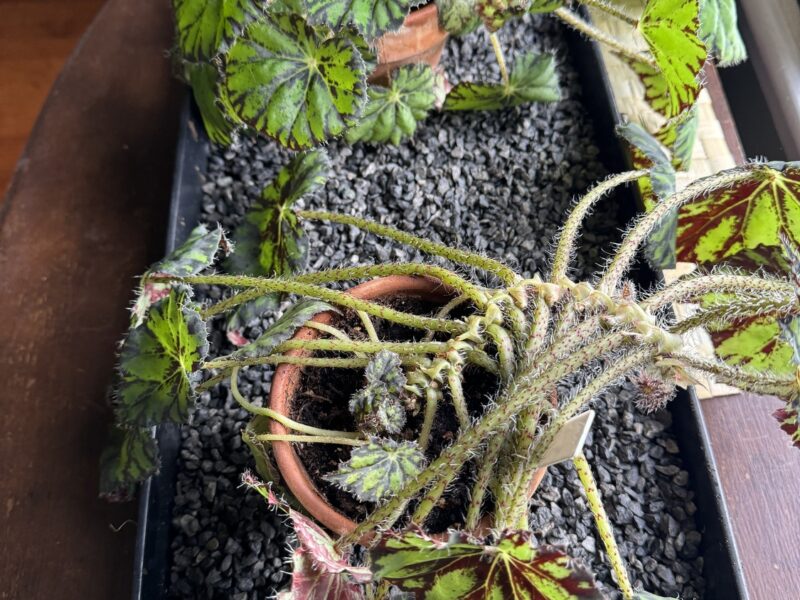

Several weeks ago, in this continuing series Houseplants 101, I reviewed how important lighting considerations are when choosing a plant. The bottom line was that without the correct lighting your plants will survive for a while, then they will struggle and eventually become problems instead of wonderful additions to your home.
When shopping for houseplants it’s important to match the plant to your home conditions, or the vast majority of the plants you buy will have to be considered disposable. Aside from their need for the plant-appropriate light the other considerations are humidity and temperature.
Humidity can be an issue for many houseplants but not all of them. The plants that fall into the category of “tropical foliage” tend to need humidity in the area of 50 percent or higher. Many succulents, including the cacti, will do with lower humidity. Flowering houseplants, which I’ll cover later, tend to need higher humidity, and some, like orchids and many Bromeliads, which get much of their moisture from the air, also need higher humidity.
Temperature should also be a consideration since nearly all these plants have tropical origins. Most do well with night temperatures five to 10 degrees lower than daytime temperatures, and the good news is that your home may have setback thermostats that drop the indoor temperature at night then raise it before you rise in the morning. Perfect for houseplants. Most tropical foliage will do well with nighttime temperatures between 60 and 65 degrees with day time temps of 65 to 72 degrees.
Plants should be kept away from vents and registers if you have a forced hot air furnace. The air from these heat outlets will be warm but most likely very dry. A plant stand or table above one of these registers may provide enough diffusion of the flowing warm air and at the same time provide some added warmth under the stand or table that will warm the plant.
Try to keep in mind that our homes, like our outside gardens, have spaces that are true microclimates, and taking advantage of these spots, like the kitchen, sunroom or even a brightly lit bathroom can be perfect habitats for certain plants. Plants near windows, however, can become very cold, and there’s a phenomena where cold air at windows tends to sink, making windowsills a very challenging place for plants. Plants set on plant stands a foot from a window will do much better than a plant directly in the sill.
The challenge here is probably in providing the right air moisture, or humidity, for your plants. Some homes have humidifiers built into the heating systems, and this is great for your plants. If you’ve got a system like this there may be no or little reason to supply supplemental humidity. Keeping a humidifier running near your plants can also be a great help and a solution.
When it comes to humidifiers there are warm mist types and evaporative types. The warm mist humidifiers are great but can be expensive to run since the water has to be heated then atomized and pushed out of the humidifier. This process uses a great deal of electricity, and some of these units produce an objectionable white dust that can accumulate on furniture and plant foliage.
An evaporative humidifier is little more than a tank of water, an evaporative pad and a fan. At low to medium speeds they can be very quiet and require much less electricity than the warm mist types. Air is drawn through the evaporative pad that absorbs and wicks the water from the tank, and the moisture is then added to the room air by the same fan. There is no white dust produced, but the wick may need to be replaced during the heating season; the wicks are relatively inexpensive. There are also cool mist ultrasonic humidifiers, but white dust and electricity consumption can be an issue.
For small rooms of less than 250 square feet you might use something like the Vornadobaby. It’s a wick-type evaporative humidifier that uses little electricity and can easily keep most rooms at 50 percent humidity. It has a humidistat and fan speed control, but there are two downsides. The first is that it does not shut off when empty, and the second is it’s got a small tank. I have one in my home office for both me and my plants. I just have to remember to fill the tank in the morning and again when I go to sleep and that works perfectly, keeping me and my plants happy.
Remember that as your house temperature falls and rises so will the humidity. Warmer air is able to hold more moisture than cooler air. A humidifier with a humidistat will resolve this problem, but if you have an automatic setback thermostat on your heating system the humidity will naturally fall at night. This isn’t a big issue. However, you should have a simple device where your plants are that displays both the temperature and humidity so you know what’s going on. These small monitors can cost less than $20 and are available online and locally.
Another option is a humidity tray. For this method you can use solid plant flats (11 by 22 inches and about 2 inches tall) that you fill with pea gravel or bluestone gravel. Make sure the flat has no drainage slits on the bottom and use two flats, one inside the other, to ensure against leaks. Fill the flat with the gravel then add water so the water level is just below the top of the gravel. Your plants can be set on the gravel and the evaporating water will add humidity to the air around the plants. You will need to add water depending on the room temperature and ambient humidity. This works well for plants in four-to-six-inch pots but not larger ones.
For larger plants you can use a plastic plant saucer that is much larger than the diameter of the bottom of the pot. Fill the saucer with gravel and add water. Don’t let the pot sit in the water but on the gravel just above the water line. You can also go online and look for plant humidity trays where you’ll find several more options.
I don’t think misting your plants with tap water is a great idea. It’s a very temporary fix, and if the plant’s canopy is wide, you’ll end up with water dripping down on the floor and furniture. Misting also results in the foliage cooling rapidly by several degrees as the water evaporates, and this can be an issue as well.
Want a nice warm and humid tropical jungle in your home? Maybe consider a terrarium. You can use an old fish tank or a commercial terrarium and use plants that you purchase in 2-inch pots. Terrariums require a bit of skill in planting and maintaining, but an old 50- or 100-gallon fish tank can be quite an attractive tropical jungle in miniature.
If you’re overwhelmed, don’t be. Get some plants, start with small ones and experiment. There are only about 100 plants that do well as houseplants of the tens of thousands that grow in the tropics. For now, if you want a great disposable houseplant that has great mottled foliage, doesn’t ask for much care and has bright colorful flowers consider the Cyclamens that most plant shops and garden centers have on sale now. They don’t need high light and prefer being grown on the cool side. They’ll flower through the winter, then, like the poinsettias, they can be composted in the spring.
Next week we’ll look at what most houseplant growers find to be the most difficult plant parenting challenge. This is the one thing that kills more houseplants than any other, but I may be able to solve this for you. Mess up on this one though and I can guarantee your plants will fail. Keep growing.
 More Posts from Andrew Messinger
More Posts from Andrew Messinger